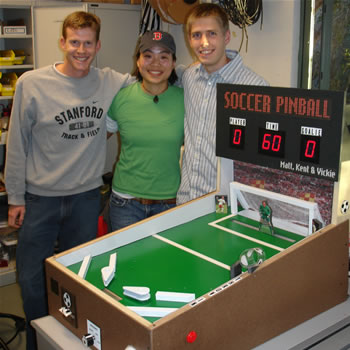Our Team
 From left to right: Kent, Vickie, & Matt with the final project. If you have questions about the project, contact us at:
From left to right: Kent, Vickie, & Matt with the final project. If you have questions about the project, contact us at:
Kent Anderson: ude.drofnats@tneka
Vickie Chiang: moc.liamg@gnaihceikciv
Matthew Hill: ude.drofnats@llihdm
Gems of Wisdom
- Start immediately! Our team left for all of Thanksgiving, but we only got away with it by pushing hard from the very start
- Eliminate complex, non-essential mechanical devices that don't really add to the function of the system. You just don't have enough time to mess with them.
- Have and guard your own tools. Constantly having to scrounge for screwdrivers and drills can add untold hours and frustration to your 218 experience. Bring your own tools, but make sure they're labeled, and guard them with your life! As a bare minimum, hot glue, a 4-way screwdriver, X-acto knife, utility knife, scissors, and metal ruler are good to keep on hand.
- Consider the full consequences of your early design decisions before you make them. For example, we did not fully consider the implications of using common cathode vs. common anode displays, nor did we read the data sheet fully. Taking a $3.00 per part price savings here meant that we doubled the complexity and cost of our circuit down the road.
- Cannibalize!! For almost any complex mechanical drive, it's worth going to the trouble to find a pre-made drive rather than fabricating your own. Our example: an old printer for the goalie drive. It's worth the hour required to take out the cartridge motor/drive train. It's simple, robust, and will save you from making it, probably at great cost in time and money. You can even find discarded items for free on craigslist or at the E-waste center on campus. The same goes for all sorts of other mechanicals!
- Wire right the first time. When you build your circuits, start using molex connectors and clean things up right away, otherwise you will waste hours debugging loose wires and connections when you integrate the various components.
- Wire lonMake all cables long enough the first time. You can always shorten them, but it sucks when you have no spare wire and a cable won't reach while trying to pull everything together the last week.
- Put together an easily accessible diagram, preferably as a header file, keeping track of your inputs and outputs to the C32
- Foam core works, but if possible build a sturdy frame of wood to mount the foam core to. It's actually easier in the end.
- If you can design things to be modular, removable, etc, do so. Also make sure you have some easy access panels to your electronics.
- Don't forget to take a video of the game before you're forced to return the C32 and power supply. You'll regret it.
- When you design something to be used by other people, make it robust! Then, make it more robust. Assume people (i.e. toddlers) will try to break it. You may know a piece is delicate, but they won't. They will abuse your project. They will climb on your project. They will do crazy things you couldn't anticipate like hold down buttons for the entire time they're playing. Over-design any interactive components.
